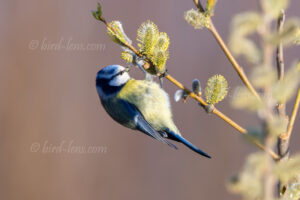 I wondered if the Blue Tit (Cyanistes caeruleus) was interested in something in the willow bushes – maybe the willow catkins – when a little bird activity at the observation tower died down. Anyway, I can see that two Blue Tits are intensively tending to the willows and the pollen from the willow catkins. At first I couldn’t tell if the tits were into the pollen or checking the willow catkins for hidden insects. I took time to observe the whole activity more closely. A Blue Tit pecks and plucks at the willow catkins with its beak. The Blue Tit does not stay long at a willow catkin, then it has already hopped on.
I wondered if the Blue Tit (Cyanistes caeruleus) was interested in something in the willow bushes – maybe the willow catkins – when a little bird activity at the observation tower died down. Anyway, I can see that two Blue Tits are intensively tending to the willows and the pollen from the willow catkins. At first I couldn’t tell if the tits were into the pollen or checking the willow catkins for hidden insects. I took time to observe the whole activity more closely. A Blue Tit pecks and plucks at the willow catkins with its beak. The Blue Tit does not stay long at a willow catkin, then it has already hopped on.
What exactly the Blue Tit eat from the willow catkins, I can’t really say. One of the Blue Tits had torn off a whole willow catkin. Whether the Blue Tits prefer to eat the flowering willow catkins or the catkin itself is very nutritious is not exactly clear. The Blue Tit also plucks off the yellow flowers with the pollen from the catkin.
For us humans, the willow catkins are simply very beautiful to look at, but I can also imagine that they are good food. The Blue Tits seem to see the willow catkins as a source of food. Whether the Blue Tits are eating the willow catkin or something inside it is impossible to tell right away.
The willow catkins are emblematic of early spring. They are so fluffy and look quite different from anything else in nature at this time. After the winter, when there are the first warm rays of the spring sun, these messengers of spring fascinate us. The spring sun and the awakening nature. Everything becomes green again and starts to bloom. These are especially memorable memories.
Willow catkins are the name given to the flowers of various willow species (Salix sp.). The yellow flowers are male. The female flowers are green. On a plant only male or only female flowers bloom. Obviously the Blue Tit on the photo has just helped itself to male pollen and dusted itself with it. Willow catkins are a protected species and must not be cut from March 1 to September 30 in Germany. This is because they are an important first source of food for wild bees and honeybees that fly out.
Bird-lens is primarily a website designed to meet the growing demand for high-quality photographs of the birds of the Western Palearctic. In order to meet the demand for top-quality photographs of rare bird species, Bird-Lens.com has also made targeted trips to the local area around. All this in order to be able to take excellent photos of birds. The yield of pictures not only of rare western Palearctic birds is very good. The beautiful picture of the blog is only a first impression, what you can find in behind the tab “Picture-Shop” very soon. Just leave a message if bird-lens.com can help with a picture.